Wood ash as fertilizer and not only: when and how to use in the garden and vegetable garden
Many gardeners rightfully believe that wood ash is the best organic fertilizer that can and should be used in the garden and vegetable garden. Moreover, it is really not only very effective, but also actually free (although, of course, you can purchase it ready-made in a garden store).
Next, we will talk in detail about what wood ash is rich in (what is its chemical composition), when and how to use it correctly for fertilizing and feeding, and also answer the most popular questions regarding its use.
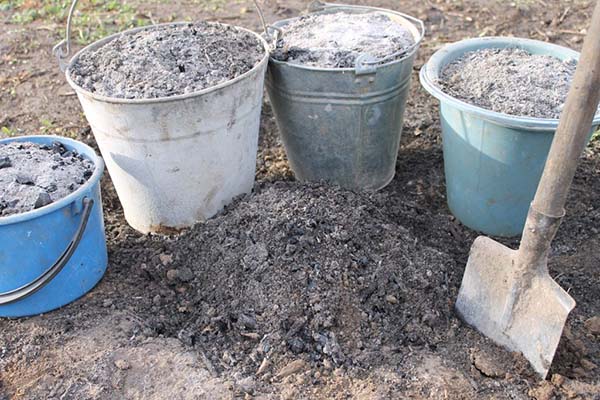
Content
Wood ash as fertilizer: chemical composition, main areas of application in the garden and vegetable garden, types
Ash is beautiful organic potash fertilizer. Moreover, in addition to the high potassium content, ash also rich in phosphorus, calcium and other important trace elements (magnesium, iron, sulfur, boron, manganese, zinc, molybdenum and others).
- So, due to the content of a large amount of calcium, it capable of quickly deacidify the soil (lower its acidity, making it more alkaline = suitable for growing vegetables).
Note! Accordingly, ash cannot be applied under plants that love acidic soilfor example blueberries, rhododendrons, azaleas, hydrangeas, heathers, various conifers.
- Is excellent a pest and disease control agent horticultural crops (usually used in the same way or with tobacco dust).
For example, during flowering, you can pollinate with dry ash. strawberry bushes from gray mold... You can also pollinate and / or spray with a soap-ash solution (+40 grams of soap per 10 liters of solution) vegetable crops - cabbage, radish, radish (from cruciferous flea), tomatoes, cucumbers, berry bushes and fruit trees, for example from aphids, wireworm, powdery mildew, black leg, keels... In this case, spraying should be carried out strictly early in the morning or in the evening, or in the afternoon, but only in cloudy weather (not rainy), and dusting should be done early in the morning, when the leaves are still wet (so that the ash sticks to the leaves better).
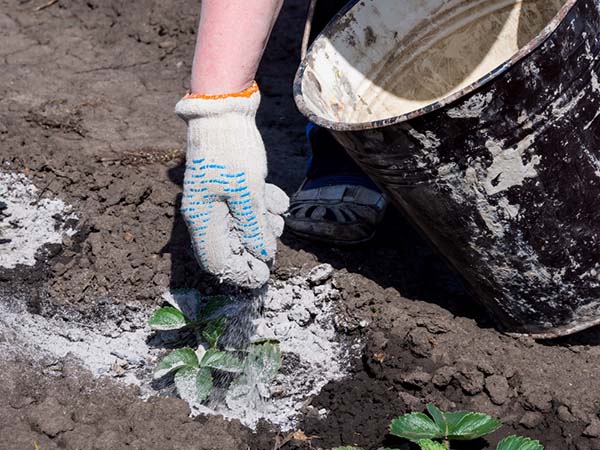
- And in a solution of wood ash you can soak seeds (tomatoes, cucumbers, eggplants) before sowing... So, in 1 liter of water dissolve 2 tbsp. tablespoons of ash (20 grams) and hold the seeds for 4-6 hours.
- Ash helps maintain environment favorable for microorganisms (microflora) and neutralizes harmful chemical compounds... In addition, adding ash to compost accelerates the decomposition of plant residues, i.e. ash is used instead of lime for alkalization.
Ash does not contain chlorine, which means that it can be used to fertilize crops that react negatively to chlorine compounds. In particular, these are potatoes, zucchini, cucumbers, carrots, strawberries (garden strawberries), raspberries, strawberries.
- Ash can be used as odor remover in the country toilet (pouring out a little after each visit).
- It is also a great remedy. for a long storage vegetables (eg, garlic).
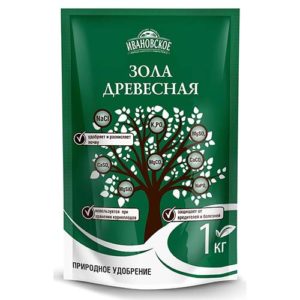
Everybody knows that wood ash obtained by combustion woodhowever, its usefulness (chemical composition) differs from breed to breed. So, the richest in macro- and microelements birch and pine ash (potassium - 10-12%, phosphorus - 4-6%, calcium - 30-40%), less - spruce (potassium - 3-4%, phosphorus - 2-3%, calcium - 23-26%).
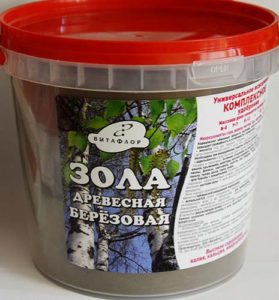
Ashes can be prepared not only by burning birch firewood: they will do any plant residues - is the same tops (especially sunflower stalks, in which potassium - 30-35%, phosphorus - 2-4%, calcium - 18-20%, potatoes - potassium - 20-22%, phosphorus - 8%, calcium - 30-32%), grass (lawn), straw... You can also use the ash obtained after burning paper (including newspapers and even colored ones) and peat briquettes.
Video: features of the use of wood ash in the garden and garden
When to fertilize plants with wood ash
Wood ash can be used throughout the season.
Ash is easy to bring for digging both in spring and autumn, but better in springsince in the fall, they usually resort to phosphorus fertilizers.
As you know, phosphorus is a long-soluble fertilizer, therefore, when applied in autumn, it is almost completely retained in the soil.But some of the potash fertilizers can be washed out by the spring, so they have to be applied again in the spring (directly into the hole when planting or as liquid dressings during the direct vegetation of the plant).
In summer, when plants begin to bloom and bear fruitThis is especially true for vegetable crops such as tomatoes and cucumbers: they require a lot of potassium, calcium and phosphorus, which are found in sufficient quantities in wood ash. And then they come to your aid liquid root dressing, or adding ash in dry form (preferably with subsequent incorporation into the soil, but it is possible without it - in any case, the ash will come to the roots with watering or rain).
How to properly use wood ash in your garden
Application methods
- Ash can be added directly into the planting hole or pit when planting vegetable, berry and fruit crops.
- Can embed in soil when digging (loosening) in spring or autumn.
- To cook liquid solution and pour under the root.
How to prepare wood ash solution
Pour a bucket of water, pour 100-200 grams of dry ash into it (a glass or 2), carefully move and immediately water or sprinkle the plants.
Advice! To increase the solubility of the elements contained in the ash, the solution can be add acid, and it is desirable vinegar - 200 ml of 9% vinegar per 10 liters.
Adding vinegar will also have a positive effect on the absorption of calcium and magnesium by the plant.

Consumption rate or in what concentration to use
Important! The ash application rate depends on soil composition, its acidity... If the soil is too acidic, and vegetables like more alkaline soils, then more. If it is already sufficiently alkaline, it is smaller (no garden culture can grow on too alkaline soils).
About, how to determine the acidity of the soil, described in detail here.
When preparing the beds, as well as for preparing liquid fertilizers, they are most often used 100-200 grams of ash per square meter or for 10 liters of water.
In 1 glass - about 100 grams of ash. In a liter jar - about 500 gr.
- If you bring ash in the hole when planting seedlings (planting tubers), then approximately 1 handful (1-2 tablespoons) + preferably mixed with earth.
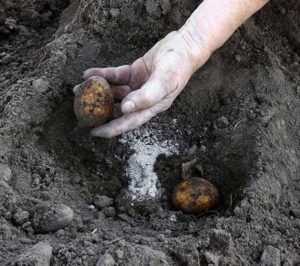
- Plant shrub or tree - 400-900 grams (in this case, it is imperative to pre-mix with the ground).
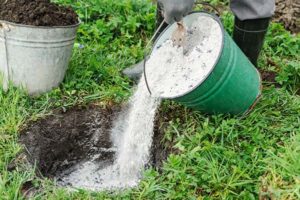
- If you do watering, then spend 0.5-2 liters per 1 plant (tomato or cucumber bush, depending on its size and fruiting).
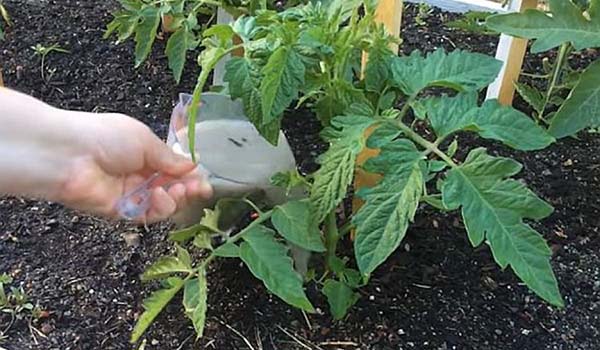
However, ash should not be used at a concentration more than 500 grams for 1 square meter when planting vegetable crops and more than 1 kg - trees and shrubs.
Especially important do not overdo it with ash when preparing a garden for potatoesotherwise he may get scab.
Terms of use
- Many people do not recommend and categorically forbid use as a fertilizer ash obtained from coal, or rather what remains after its combustion - slag.
However, there is alternative opinionthat such ash can be used, on the contrary, to increase soil acidity.
- It must not be allowed that various not plant litter type plastic packaging, plastic bags, rubber.
- If you are preparing the ash yourself, then you need to eventually no embers left... The more thoroughly the wood is burned out, the more available minerals will be (in fact, you need "ash").
- Respectively, before use desirable sift the ash from the coals.
- It is not recommended to mix wood ash with any phosphoric and nitrogen fertilizers. (especially for fresh manure), and in any form (liquid, dry).
Worth knowing! Simultaneous use of ash with nitrogen fertilizers leads to losses of nitrogen in them (except for compost, ash, on the contrary, accelerates the decomposition of plant residues - used instead of lime for alkalization).
The same goes for mixing wood ash (like any other soil deoxidizer) with phosphorus fertilizerswhich leads to the fact that part of the phosphorus is converted into an insoluble state.
Therefore, between them you need space... For example, apply nitrogen fertilizers for spring digging, and pour wood ash directly into the hole before sowing seeds or planting seedlings (or vice versa). Phosphate fertilizers are always applied strictly in the fall.
Video: how to properly use ash in the garden and vegetable garden
Popular questions and answers regarding the use of wood ash
- Can you use only wood ash as fertilizer on your site?
Of course, this will not be enough. Ash is not a complex fertilizer. As stated earlier, ash does not contain nitrogen, which is necessary for the initial growth of green mass in all plants. Therefore:
- If you do not want to use any "chemistry" (you are a supporter of organic farming), then manure can be used as nitrogen fertilizers, and even better, compost and humus, dry granular chicken manure, liquid mullein.
- If you allow the use of nitrogen mineral fertilizers, then your choice is ammonium nitrate, urea (carbamide) other.
However! Remember that ash should not be used simultaneously with nitrogen fertilizers, otherwise the effectiveness of such feeding will be reduced to nothing (some of the nitrogen will simply evaporate).
- Is the ash from the barbecue suitable?
If you go there do not throw plastic cups and other non-plant residues, did not use chemical liquids for ignition, then completely.
- How much wood ash can be stored, how to store it correctly?
Ash has no expiration date, but under an important condition - on her should not get moisture. Otherwise, most of the useful elements will simply be washed out of it. In other words, the storage space must be dry.
After freezing and thawing, the ash also does not lose its properties.
- I read somewhere on the Internet that wood ash loses its properties when it comes into contact with water, is it so?
When in contact with water, ash really loses some of its useful properties, but this applies specifically to the process of its storage (Therefore, it must be stored in a dry, closed room or under a canopy!). If you scattered ash in the plant's near-stem circle, then it will just begin to act after watering or rain (i.e. nutritional properties will go to the plant roots).
Thus, now you know how you can use wood ash, which crops and in what concentration to feed, when it is better to do it, in what way. Good luck!
Just do not torture your neighbors with smoke from your fires!
Video: all the rules for using wood ash in the garden

